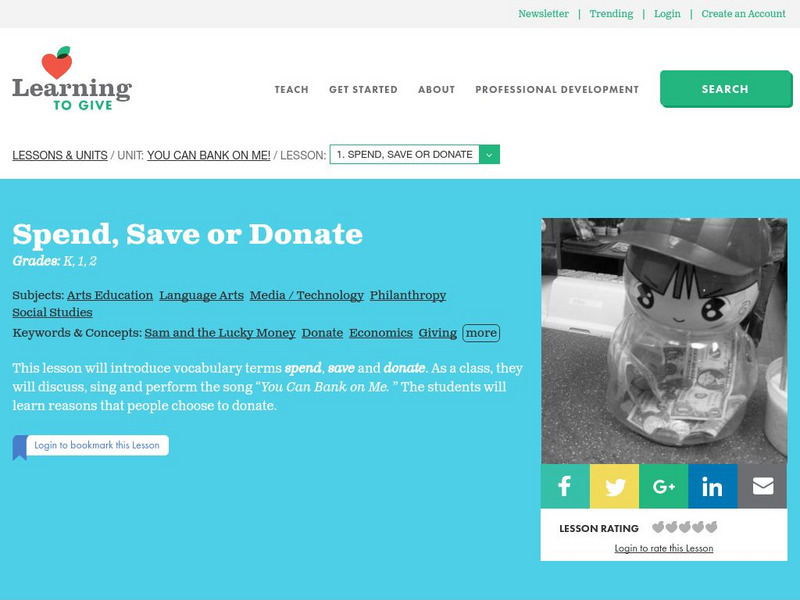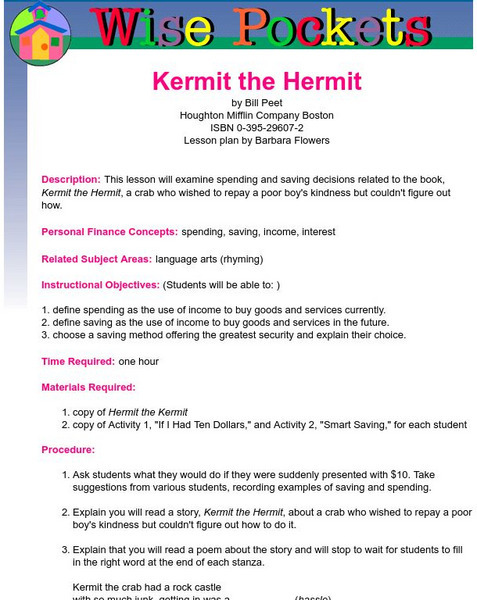Hi, what do you want to do?
Curated OER
Credit: Buy Now & Pay More Later
High schoolers analyze the costs and benefits of using credit cards to purchase goods and services.
Curated OER
State Government Debt in Utah: Rapid Growth in Recent Years
Students examine growth of debt in Utah state government from 1991 to present, compare general obligation debt and revenue debt incurred by state, identify four primary methods used by governments to finance projects, and complete...
Curated OER
Banking on the Future: Penny Drive
Students study why philanthropy is needed and learn to complete a penny drive. For this philanthropy lesson, students learn the need to invest money for future purposes and identify a cause in the community to hold a penny drive for.
Curated OER
Making Choices
Students solve word problems relating to economic choices. In this economic choices lesson, students discuss the importance of budgeting and how to save money. Students complete a economic choices worksheet.
Curated OER
Balance the Budget
Students make their own decisions over how central government should spend the money they get from taxing the public. They discuss where they could get more money from and how does spending and taxation outlined in the budget affect kids.
Curated OER
Water Quality Issues
In this unit of lessons, learners examine water quality issues. They discover ways they can conserve water and practice making drinkable water from water desalination.
Curated OER
Hurricane Katrina Relief
Learners create a song about philanthropy. They work together to develop a list of ways to donate money. They choose an aid organization which helped victims of Hurricane Katrina to receive their donation. They reflect on their...
Curated OER
How To Use The Internet To Do Comparison Shopping
Pupils learn about the community by engaging in a market shopping project. The instructional activity is for EL learners and key vocabulary is given. The teaching method is using the Spanish and English languages to increase literacy.
Curated OER
Stock It To Me
Students investigate the stock market using stock market tables, charts, and graphs. They participate in a simulation of stock market investment over time. They read about the history of Wall Street and the Stock Market.
Curated OER
Dumptown Game
Students engage in an interactive play scenario. They are the new managers of a fictional city and live in a place where nothing is recycled. Students are faced with various problems that need to be solved. They work together to propose...
Curated OER
Bookkeeping 101
Young scholars state the important questions that must be answered through the use of expense records. They design and test a method for recording business expenses.
Curated OER
Giving
Students analyze the true meaning of giving in this three part instructional activity. First, the students make a fanciful wish for a loved one. Second, they students make hand-made presents such as stepping-stones for the school...
Curated OER
Lesson 3: What Happens When a Bank Makes a Loan?
Students role-play to show how bank loans made to people can have an impact on others in the community. In small groups, they analyze hypothetical loans, using flow charts or other diagrams to describe the probable impact of each.
Curated OER
Disaster Relief - You Can Count On Me!
Students practice stewardship. In this service learning lesson plan, students respond to those in need after a natural disaster as they investigate philanthropy.
Curated OER
Expensive Choices
Eighth graders work in pairs to discover how to prioritize expenses in a budget.
Scholastic
Scholastic: Adventures in Math: Lesson 2: Money Planning
What can we do with money? Deciding on the best use of our money requires planning. Students will identify ways that money can be used: spending, saving, and giving.
Learning to Give
Learning to Give: Spend, Save or Donate
This lesson will introduce vocabulary terms spend, save and donate. As a class, they will discuss, sing and perform the song "You Can Bank on Me. " The students will learn reasons that people choose to donate.
Practical Money Skills
Practical Money Skills: Lesson Two: Spending Plans
This lesson introduces children to the concept of dividing their money into categories, namely "save," "spend," and "share" and presents activities that will help them understand that money is limited in quantity and must be divided for...
University of Missouri
University of Missouri: Wise Pockets: Berenstain Bears' Trouble With Money
Using a Berenstain Bears' book, students are introduced to concepts such as spending, goods, services, income, saving, and interest. Lesson is detailed and has good activities. Includes questions about the story that teach students about...
Council for Economic Education
Econ Ed Link: We Are Consumers and Producers
This lesson plan is geared toward beginning economics concepts. "In this lesson you are going to learn more about how you and others are consumers and producers."
Other
Money Management International: The Berenstain Bears' Trouble With Money
A lesson plan featuring the Berenstain Bears that introduces the concepts of spending, goods, services, income, saving, and interest.
University of Missouri
University of Missouri St. Louis:wise Pockets: Kermit the Hermit
This is an elementary level instructional activity that deals with spending, saving, income, and interest. Requires the book Kermit the Hermit by Bill Peet. Includes detailed lesson plan along with procedures and activities.
Scholastic
Scholastic: Adventures in Math: Lesson 4: How to Use Your Money
In this lesson, students will identify why having a budget and keeping records of their spending and saving habits helps them make better financial choices.
University of Missouri
Wise Pockets: Personal Finance Lesson Plans, Grades 3 6
The Wise Pockets World Schoolhouse presents a dozen lesson plans based on children's books and teaching money management. All include lesson descriptions, cross-curricular connections, instructional objectives, activity sheets,...




























